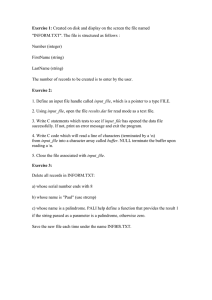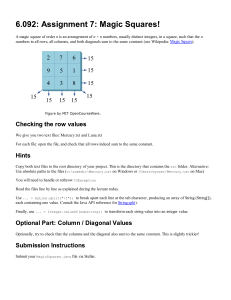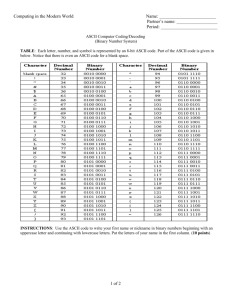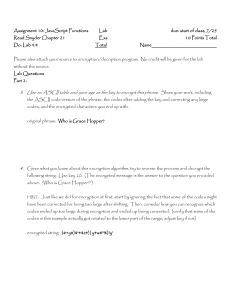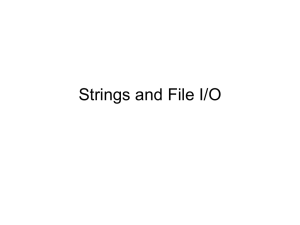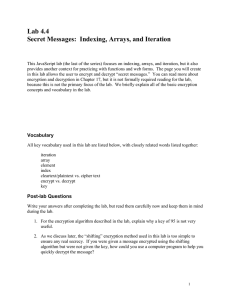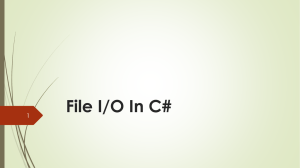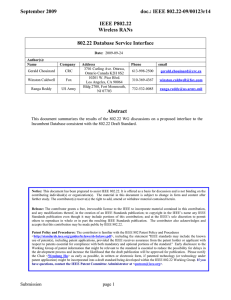Working with Files CSC 161: The Art of Programming Prof. Henry Kautz 11/9/2009
advertisement
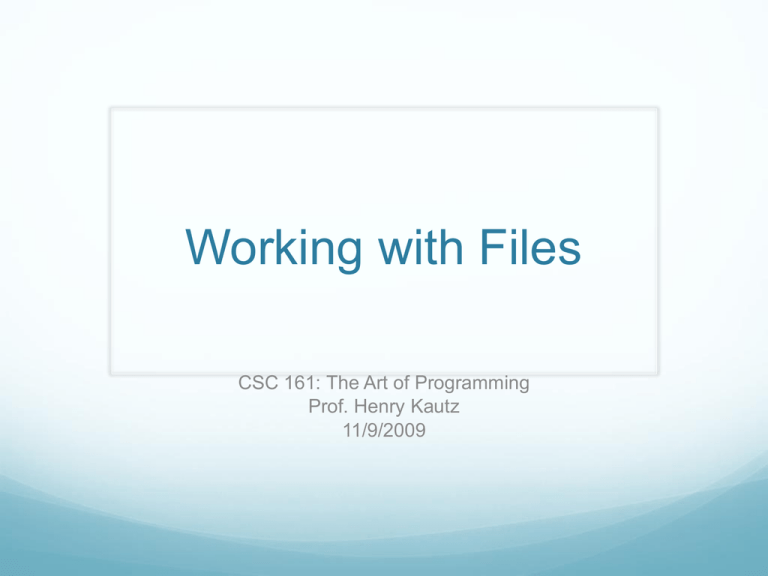
Working with Files
CSC 161: The Art of Programming
Prof. Henry Kautz
11/9/2009
What is Text?
By "plain text" we mean one of the standard methods
for encoding characters as numeric values
ASCII
Most common, uses 8-bits (one byte) per character
Example: 'A' is
01000001 in binary (base 2)
101 in octal (base 8)
65 in decimal (base 10)
41 in hexadecimal (base 16)
2
3
Beyond ASCII
Because ASCII uses an 8-bit code, there are 256
possible ASCII characters
How to handles languages with larger character sets
(e.g. Chinese)? What if we want to mix languages on a
page?
Unicode: international standard using 16-bit or 32-bit
characters
16-bits = 64,000 different characters
32-bits = 4 million different characters
Unique code for every character of every human
language
4
Unicode Examples
5
Review: Working with Text Files
f = open("My file.txt", "r")
f gets a file object
Mode is "r" for reading, "w" for writing an Ascii (8-bit) text
file
contents = f.read()
Reads entire file, returns entire text as one long string
Special characters '\r' or '\n' (or both) separate lines
Note: special characters are PRINTED as two characters,
but are stored as one 8-bit character!
6
Reading a Text File Incrementally
f.readline()
Reads one line from the return, returns that line as a string
Next call to readline() will return the next line of file
Special Python shortcut:
for line in <file object>:
do something with line
Example:
dickens = open('two-cities.txt','r')
count = 0
for line in dickens:
count = count + 1
print "The number of lines is ", count
7
Text Output
f = open("results.txt", "w")
Mode is 'w' for writing text files
if file already exists, it is erased
f.write(data)
Writes data to (end of) file
f.close()
Tells the computer you are done using file object f
If you leave it out, your file might not be properly stored
on the computer's hard disk
8
Performing String Operations
on Files
Replacing a phrase in a file:
9
file-test.txt
10
file-result.txt
11
Performing Mathematical
Operations on Files
Task: Take the average of 1,000,000 numbers
Scientific data is often this large or larger
Warning: Don't try this in Excel!
12
Result
13
Where Did the Data Come From?
14
More Complex Pattern Matching
Task: find telephone numbers in a file
Example: 234-3208
Pattern: three digits, a dash -, four digits
Patterns like this can be written as what are called
"regular expressions" in linguistics and computer
science
[0-9]{3}-[0-9]{4}
[0-9] Match any character from '0' to '9'
{3}
Match previous part 3 times
{4}
Match previous part 6 times
15
Print Matching Lines
16
Python re Module
Almost any kind of text mangling can be easily
programmed using the re module
Can find complicated patterns, pull out pieces of the
match, replace with other string...
Many applications in both day to day data processing
as well as linguistics, artificial intelligence, and (of
course) literary analysis
17
Movies of the Day
18
Status
Wednesday:
Quiz on Functions, Lists, & Dictionaries
Lecture: Working with Audio
Saturday:
Assignment 7 due
19
